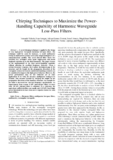Mostrar el registro sencillo del ítem
Chirping techniques to maximize the power-handling capability of harmonic waveguide low-pass filters
| dc.creator | Teberio Berdún, Fernando | es_ES |
| dc.creator | Arregui Padilla, Iván | es_ES |
| dc.creator | Gómez Torrent, Adrián | es_ES |
| dc.creator | Arnedo Gil, Israel | es_ES |
| dc.creator | Chudzik, Magdalena | es_ES |
| dc.creator | Zedler, Michael | es_ES |
| dc.creator | Goertz, Franz-Josef | es_ES |
| dc.creator | Jost, Rolf | es_ES |
| dc.creator | Lopetegui Beregaña, José María | es_ES |
| dc.creator | Gómez Laso, Miguel Ángel | es_ES |
| dc.date.accessioned | 2016-09-07T14:39:46Z | |
| dc.date.available | 2016-09-07T14:39:46Z | |
| dc.date.issued | 2016 | |
| dc.identifier.issn | 0018-9480 (Print) | |
| dc.identifier.issn | 1557-9670 (Electronic) | |
| dc.identifier.uri | https://hdl.handle.net/2454/21711 | |
| dc.description.abstract | A novel chirping technique is applied to the design of very high-power waveguide harmonic low-pass filters. The technique could be used, for instance, to avoid multipactor testing in multicarrier systems such as the output multiplexer of a communications satellite. The novel chirped filter shows low insertion loss, all higher order mode suppression, and broad stopband rejection up to the third harmonic. This paper focuses on the maximization of the filter power-handling capability without affecting its excellent frequency behavior. Given a certain frequency response, the E-plane mechanical gap of the structure and the length (in the propagation direction) of the waveguide sections between its constituent bandstop elements can be considered to improve the high-power behavior. However, the power performance may not be sufficient yet in some applications if we wish, for instance, multipactor testing to be avoided. This becomes feasible by chirping the length (in the propagation direction) of the bandstop elements. An example for Ku band is discussed for relevant frequency specifications. An improvement from ∼8 kW (non-chirped filter) to more than 100 kW (chirped filter) is obtained. As a reference, the equivalent waffle-iron filter can handle only 0.15 kW. Such high-power threshold levels have never been reported before for such kind of filters. | es_ES |
| dc.description.sponsorship | This work was supported by the Spanish Ministry of Science and Innovation under Project TEC 2014-55735‐C3‐R. | en |
| dc.format.mimetype | application/pdf | en |
| dc.language.iso | eng | en |
| dc.publisher | IEEE | en |
| dc.relation.ispartof | IEEE Transactions on Microwave Theory and Techniques, vol. 64, no. 9, September 2016 | en |
| dc.rights | © 2016 IEEE. Personal use of this material is permitted. Permission from IEEE must be obtained for all other uses, in any current or future media, including reprinting/republishing this material for advertising or promotional purposes, creating new collective works, for resale or redistribution to servers or lists, or reuse of any copyrighted component of this work in other works. | en |
| dc.subject | Harmonic filters | en |
| dc.subject | Low-pass filters | en |
| dc.subject | Multicarrier | en |
| dc.subject | Multipactor | en |
| dc.subject | Rectangular waveguide | en |
| dc.title | Chirping techniques to maximize the power-handling capability of harmonic waveguide low-pass filters | en |
| dc.type | Artículo / Artikulua | es |
| dc.type | info:eu-repo/semantics/article | en |
| dc.contributor.department | Ingeniería Eléctrica y Electrónica | es_ES |
| dc.contributor.department | Ingeniaritza Elektrikoa eta Elektronikoa | eu |
| dc.rights.accessRights | Acceso abierto / Sarbide irekia | es |
| dc.rights.accessRights | info:eu-repo/semantics/openAccess | en |
| dc.identifier.doi | 10.1109/TMTT.2016.2586479 | |
| dc.relation.projectID | info:eu-repo/grantAgreement/MINECO//TEC2014-55735-C3-3-R/ES/ | en |
| dc.relation.publisherversion | https://dx.doi.org/10.1109/TMTT.2016.2586479 | |
| dc.type.version | Versión aceptada / Onetsi den bertsioa | es |
| dc.type.version | info:eu-repo/semantics/acceptedVersion | en |


